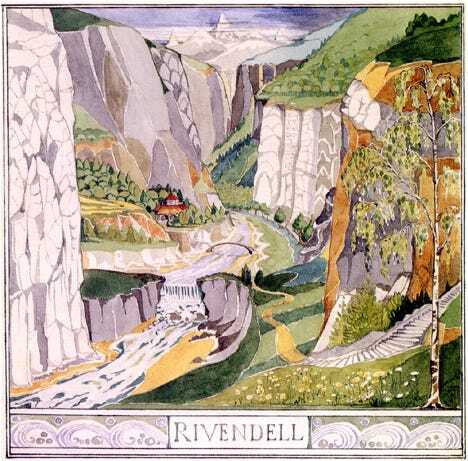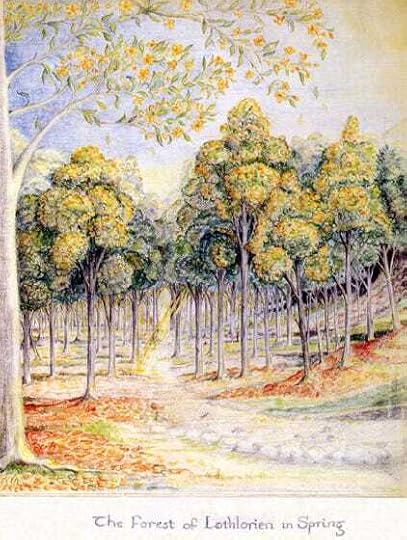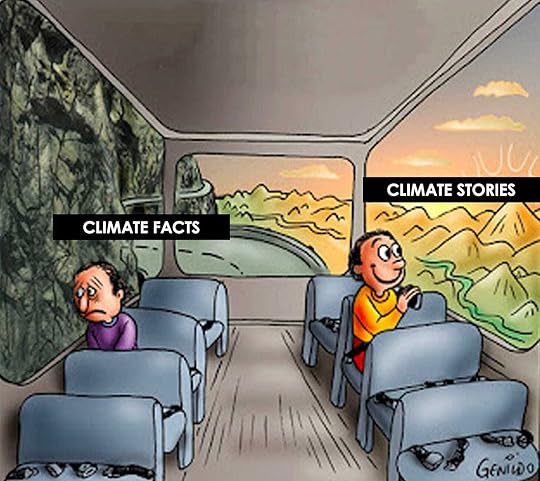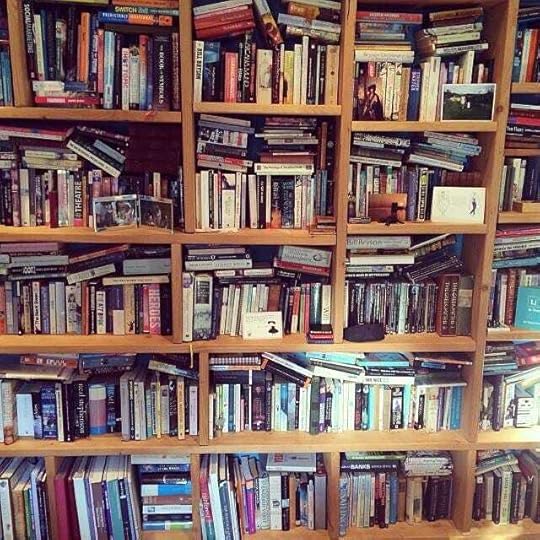Solitaire Townsend's Blog, page 3
March 9, 2025
Why The Lord Of The Rings Is My Ultimate Climate Fiction

What do you think of when I say ‘climate fiction’? Perhaps a dystopian story of water wars, characters fleeing resource collapse, or even futuristic solarpunk. I love all those narratives and have gobbled up literally hundreds of novels in those genres over the years.
But, working every day in climate action ain’t easy, and sometimes I don’t want to read about a dystopia that feels almost imminent. My friends with ‘normal’ jobs dip a toe into climate change news, only occasionally. If they feel particularly harried or vulnerable, they might ‘take a break from all that climate stuff’ for a while.
It’s my day job. Every email, meeting, powerpoint, video-call, conference and document is filled with triggers about cataclysmic and existential threats. So, where do I turn for solace?
For me, there is one story to rule them all. A series I’ll admit to having read over 100 times and which beloved lines from pop into my head during UN meetings and corporate workshops.
For me, the ultimate climate fiction that captures not merely the threat but the spirit we need to confront the crisis was penned long before the term "climate change" even entered public discourse. And there is so much we can learn from it about communicating climate action today.
J.R.R. Tolkien’s The Lord of the Rings wraps the solution to climate change in a narrative that trancends time. Many readers have noted that the epic is a parable for ecological destruction (and Tolkien referred to it as such in interviews). But it’s also a mythos for hope, action, and transformation in the face of overwhelming odds. This is a blueprint, with lessons in storytelling we’d do well to follow;
The Enemy Isn’t Sauron
Tolkien’s central villain, Sauron, is a force of ever-increasing domination, greed, and industrialized destruction, bent on twisting nature and people to fulfill his own ends. Sound familiar? His vast war machine isn’t just a military threat; it’s an assault on the natural world itself. The scarred and barren wastelands of Mordor could easily be a description of today’s totalitarian industrialisation.
“Here nothing lived, not even the leprous growths that feed on rottenness. The gasping pools were choked with ash and crawling muds, sickly white and grey, as if the mountains had vomited the filth of their entrails upon the lands about. High mounds of crushed and powdered rock, great cones of earth fire-blasted and poison-stained, stood like an obscene graveyard in endless rows, slowly revealed in the reluctant light.”
We have our own Mordors growing across the world; the waste-moutains, oil-spills, abandoned quarries, war-blasted cities and chemically polluted rivers.
But Sauron was never the one who scared me most as a young girl, reading LOTR under blankets far past my bedtime. Sauron was bad, but Saruman really made my skin crawl.
Sauron’s most willing accomplice, the fallen magician Saruman, offers a chillingly modern motivation for his betrayal of his old values;
“A new power is rising. Against it the old allies and policies will not avail us at all…This then is one choice before you, before us. We may join with that Power…There is hope that way. Its victory is at hand; and there will be rich reward for those that aided it:
It’s a prophetic echo of the mindset that values power over everything else. Saruman, like so many modern titans of industry, believes life is a resource to be consumed, not to be cherished. Treebeard isn’t subtle when setting out Saruman’s twisted ambitions;
“He is plotting to become a Power. He has a mind of metal and wheels; and he does not care for growing things, except as far as they serve him for the moment.”
What Tolkien saw clearly was how corruption begets corruption, even in those who didn’t start that way. A story that tends to repeat…
A few years ago, many environmentalists (including me) lauded a certain electric car entrepreneur for driving an EV renaissance. He was deep in all our councils. Then he claimed a beautiful space for himself, that had been full of tweeting birds, and swiftly debased it into a filthy pit. Now it seems his mind has been fully captured by the greed and violence offered to him. Formerly respected magicians becoming murderous side-kicks to power-hungry despots? Tolkien was precient.
The corrupting drive of greed drives so many of the dark forces in the LOTR stories - from the power-hungry kings who became ringwraiths to the stalkerish obsessions of Wormtongue.
But Tolkien carefully nudges us to the realisation that the enemy isn’t Sauron himself. The enemy is what it’s always been: an insatiable desire for power, no matter the cost to others.
The Heroes We Need
The magic of The Lord of the Rings, which makes it the ultimate climate story, is that power does not only rest in the hands of the powerful. In the final moments, it’s not the numinous Elves, mighty human warriors or even the resurrected magician Gandalf who hold the key to saving the world. Just when everything seems lost, the world is saved by hobbits: ordinary, unassuming little folk with no special powers, just stubborn hope, love for their home, and a willingness to try.
Frodo and Sam’s journey into Mordor is a masterclass in climate storytelling and even climate psychology. Time and again, they confront the sense that the task is too big, too impossible, too late. Yet, Sam holds on:
“It's like in the great stories, Mr. Frodo. The ones that really mattered. Full of darkness and danger they were. And sometimes you didn't want to know the end. Because how could the end be happy? How could the world go back to the way it was when so much bad had happened? But in the end, it’s only a passing thing, this shadow. Even darkness must pass. A new day will come. And when the sun shines it will shine out the clearer.”
This is a quote I return to again and again. I have it printed and pinned above my desk to re-read when I’m struggling with my real-world Mount Doom. Versions of this sentiment flicker at the heart of the climate movement today: youth strikers, Indigenous defenders, farmers, scientists, sustainability workers, parents and community leaders stepping up because they must - not because they are uniquely equipped, but because they care too much to do nothing. Like Sam and Frodo, they carry the burden, even though they never asked for it.
And crucially, they do not act alone. Just as the Fellowship forms across cultures, races, and languages, so does the climate movement bring together a diverse coalition of communities, all realizing that no one can solve this crisis alone.
We are our own Climate Fellowship of unexpected and mismatched allies, and that’s a beautiful thing.
One Line That Always Gets Me Sobbing
Tolkien does not shy away from the crushing scale of the task. Climate fiction, too, must grapple with the enormity of the rising seas and burning forests, and the existential weight of planetary crisis. Sam feels it when they stumble through Mordor:
“I can’t carry it for you, but I can carry you.”
That single line is the distilled essence of climate solidarity. No one can carry the crisis alone, but we can carry each other through it.
Nature That LIVES
The Lord of the Rings is widely recognised as ‘eco-fiction’ for its reverence for the natural world.
From the golden woods of Lothlórien to the wild, untamed peaks of the Misty Mountains, Tolkien’s landscapes aren’t just backdrops, they are characters with stories, wisdom, and intrinsic value.

The natural world in Tolkien’s world is sacred and ancient, and it is worth saving not because of its utility but because of its inherent beauty and mystery.
Of course, Tolkien himself was deeply disturbed by the impacts of industrialisation when he wrote, "The country in which I lived in childhood was being shabbily destroyed before I was ten." But he still manages to see the magic incarnate within nature and when we read Lord of the Rings, perhaps we do too.
Re-making The Shire
One essential part of The Lord of the Rings is that it does not end with a return to the status quo. The world isn’t ‘returned’ to the same state. With the Scouring of the Shire, the hobbits return home to find their beloved land ravaged by Saruman’s last gasp of industrial cruelty. But they do not despair. They rebuild. Not exactly as before, but better. With soil and a seed from Galadriel’s garden, Sam replants the trees, including a single mallorn, the only one of its kind in the Shire;
When the tree bloomed in the next summer it was said that all the Shire became golden from the flowers
The future can’t just be a desperate clawing back to the past but a transformed world, richer for the struggle it has endured.
A Timeless Climate Story
Tolkien understood a profound insight: that the fight for the future of the earth is not fought in grand gestures but in small acts of courage, stubborn hope, and deep love for place and people. Unexpected allies can be the real magic to change the course of even the worst crisis.
That is the heart of all great climate stories. They don’t just warn us of impending catastrophe, but they remind us that we are part of a great, unfolding tale. One where our ending is still unwritten.
“I wish it need not have happened in my time,” said Frodo.
“So do I,” said Gandalf, “and so do all who live to see such times. But that is not for them to decide. All we have to decide is what to do with the time that is given us.”
[Thank you for reading. Please comment with your favorite climate fiction and why it moves you! And of course, please subscribe and share with others - hantanyë tyen]
March 2, 2025
What Writing A Novel Has Taught Me About Climate Communications

Over decades of working in climate action, people have often sadly assured me that, ‘We’re in the worst possible situation, so we’re doomed.’ But that sentiment is equally as hilarious as it is absurd. Because we’re actually in an excellent position to solve climate change – mainly because of outstanding climate science and huge leaps in renewable technology.
Imagine if we had no science to explain what’s happening to our weather, or no renewables ready to replace current energy systems?
My irritation with climate doomism inspired me to imagine a world without the advantages of ours. It's one in which petrol is the only energy, and even electricity is unknown, made worse by extreme weather being blamed on angry gods rather than understood by science. Now, writing a world like that was a challenge for an optimist like me!
My upcoming novel Godstorm is in a new genre called cli-fi, aka climate fiction (Godstorm will be on pre-order this spring and published in Jan 2026). The journey of writing cli-fi challenged almost everything I thought I knew about climate communication. Because true storytelling hacks into a much deeper part of human psychology – our imaginative, mythos-constructed programming. A part of us that standard climate messages and news don’t often reach.
I had to flip my attitudes to learn that;
1. It’s All About People, Not Carbon
Scientists talk in parts per million of carbon in our atmospher (CO2e ppm). Activists talk about 1.5-degree targets. But stories? Stories talk about people. Every novel-writing guide and creative writing teacher starts with a golden rule of storytelling: it’s all about character.
Oh, world-building, pace, beautiful prose, and strong themes matter. But without compelling and memorable characters, your story won’t be read.
That taught me that climate communication shouldn’t start with "the Arctic ice sheet is melting at an unprecedented rate." It starts with "Meet Sofia. She just lost her home to a wildfire." Or "Jamal worked for years just to make solar panels that can survive desert dust."
In writing my novel, I realized that the heart of cli-fi - and of any successful climate message - is an emotional connection with human beings (or anthropomorphised voices). That’s because readers needed to feel climate change, not just understand it. and we feel through empathy. Readers have to love (or hate) the characters, cry for them, and cheer them on or cheer for their downfall. Research tells us that we believe anecdotes over facts, and in a novel/story you can go deep into that human trait, spinning out an anecdote into a deep exploration of the mindsets that can match the challenge of climate.
When you meet the governess at the heart of my story, she isn’t a scientist, activist or very important person at all. Her job is to teach and protect a little girl. But as that job becomes much more dangerous, we learn with her about the realities of her world, and what it will take to change it.
And one of my biggest learnings might be hard to hear…

2. The Bad Guys Think They’re the Good Guys
In climate discourse, it’s easy to find villains: the oil barons, the politicians dragging their feet, the companies spewing emissions with reckless abandon. But writing a novel requires believable characters, and that means no villain can recognise themselves as a villain.
The oil-obsessed Consul in my book isn’t sitting in a leather chair, cackling over rising sea levels, happy to destroy the world. He is rational and responsible. He believes in keeping the economy of the Empire afloat, preventing mass unemployment, and providing energy security. In his mind, he isn’t the problem.
Writing a compelling and believable ‘bad guy’ was a revelation for me. No one thinks they are the bad guy. And even if you present them with overwhelming evidence (in your opinion) that they are, they’ll dismiss you as holding dangerous values or not understanding how things work.
If climate communicators want to shift behavior, we need to understand why people resist being cast as the problem. Fear, economic concerns, and a sense of helplessness often underpin climate inaction more than outright denial. To communicate effectively, we need to engage with those concerns, not simply demonize those who hold them.
Oh, we still need to win. But trying to convince folks they are bad/wrong/the problem makes for an unbelievable narrative in fiction and failing messages in the real world.
3. There Must Always Be Hope (Even Just A Little)
Many author friends are writing gritty, sometimes even terrifying, books about terrible things. Especially the memoir writers who share stories of hardship and exploration that are hard to bear. But even those setting out brutal dystopias have received the same feedback from agents and publishers – you need a seed of hope if you want to sell your book.
Of course, other writers’ centre ‘hope’ as their main theme (Becky Chambers’ Psalm for the Wild Built is an excellent example). These upfliting ‘up-lit’ novels have stormed up bestseller lists over the past few years
We love reading dystopias, but only if people are actively fighting against them and trying to build something better! So many climate communicators seem to forget that the purpose of dystopian messaging isn’t the fear – it’s the fight against the fear. People need to believe that change is possible, that solutions exist, that taking action is worth it – even when facing overwhelming odds. The most engaging parts of my book aren’t the disasters and betrayals, the fights and failures, but the moments when characters find a way forward: when they simply refused to give up.
This aligns with what climate psychology tells us - that fear without agency leads to paralysis. If we want action, we need to sell a future worth fighting for. Optimism isn’t naïve; it’s an essential storytelling trope.
4. Culture Moves Faster Than Policy
Governments are slow. Markets are sluggish. But culture? Culture can shift in an instant. A single movie, book, or viral meme can reshape public perception faster than a thousand policy papers. I love my novel Godstorm, but I don’t pretend to think it will be the one story to move the mountains.
It will be one if millions of stones clattering down the mountain.
We need a huge wave of culture-shaping narratives. What if more climate stories dominated mainstream entertainment? What if sustainability wasn’t just a "niche concern" but an unavoidable backdrop of everyday storytelling? The more we weave climate consciousness into popular culture, the faster it will become a societal norm.
As climate communicators, we should be taking notes from sci-fi and fantasy. For me, watching Star Trek as a child did more to encourage heroism and responsibility than any public service campaign or school lesson. So why not do the same for climate action? Storytelling isn’t a side dish in climate communications—it’s the main course.
5. We Need More Genre Diversity in Climate Stories
Climate stories can’t all be the same. Not everyone wants to read an "issue-driven" novel or watch another "important documentary." Climate themes need to seep into every genre—comedy, mystery, historical fiction, even romance.
Imagine a rom-com where the meet-cute happens during a climate protest. A murder mystery set against the backdrop of corporate environmental fraud. A sports drama where an athlete fights for sustainability in their industry. The more varied our climate storytelling, the more people we reach.
Stories Always Win
Writing a cli-fi novel didn’t just teach me about character arcs and plot twists—it taught me that climate change is a story. The best climate communication takes people on a deeply human journey, makes them feel something, and leaves them believing that the future is still worth fighting for.
So, if you want to change the world, don’t just write another white paper. Write a story. The planet needs more storytellers.
February 22, 2025
The Joys Of Climate Fiction
Ah, the joys of climate fiction (cli-fi) writing. Where saving the planet meets the blank page, and where existential dread and solutions-obsession get their own plotline! Writing cli-fi is like trying to pen a love letter while the house is on fire: thrilling, urgent, and slightly singed around the edges.
We need more climate storytelling, in novels, movies, TV and social media. But that moral muse isn’t the only motivation for weaving climate stories into creative output. It’s a emotional journey too. For years I’ve worked on Godstorm, my debut cli-fi novel. I started writing as another tactic of climate action. But I will admit I continued not out of a compulsion to try and save the world, but because of a deep sense of personal satisfaction in the craft of cli-fi;
Thanks for reading Solitaire's Storytelling! Subscribe for free to receive new posts and support my work.
Becoming a Narrative Alchemist: Ever wanted to turn scientific jargon into gripping tales? Welcome to cli-fi, where you transmute carbon footprints into character arcs and melting ice caps into melting hearts. It's storytelling with a mission, and you're the eco-bard.
Channeling Your Inner Cassandra: Embrace your role as the modern-day soothsayer. Through your tales, you get to shout, "The glaciers are coming!" while everyone else debates the weather. It's both cathartic and, let's face it, very dramatic (a good thing in fiction.
Crafting Hope: Yes, the world might be teetering on the brink, but in your stories, there's always a solar-powered light at the end of the tunnel. You can imagine scenarios where (some) humans are getting their act together—it's like therapy, but with more plot twists.
But while writing Godstorm has been deeply satisfying, as a debut novelist, I’ve had a few bumps in the road;
Decoding the Science Gobbledygook: Let's be real: phrases like "anthropogenic radiative forcing" aren't exactly muse material. But don't let the techno-babble intimidate you. Break it down, consult a friendly expert, or use the ultimate writer's tool: creative license (with a sprinkle of accuracy). I’ll write again about the experience of having Godstorm ‘peer reviewed’ by a climate scientist!
Avoiding the Preachy Pitfall: Nobody likes a story that reads like a PSA. Weave your eco-themes into the fabric of your narrative. Let characters grapple with climate issues organically—preferably without turning every dialogue into a TED Talk. I set out to write a climate story, but the atmosphere isn’t a character. In Godstorm, I’ve pulled a cracking narrative out of some climate worldbuilding.
Silencing the Inner Critic: Ah, imposter syndrome—the uninvited guest at every author's party. Remember, even the greats had their doubts. Arm yourself with knowledge, join a community of like-minded writers, and when in doubt, write through the fear. Decades of working in climate was great preparation for author anxiety!
Read More Climate Fiction
To fuel your inspiration and keep the eco-anxiety at bay, dive into these tales that blend environmental themes with a dash of optimism:
The Ministry for the Future by Kim Stanley Robinson
A rollercoaster of climate solutions and geopolitical drama, this novel offers a hopeful (and occasionally hair-raising) vision of our future.
A Psalm for the Wild-Built by Becky Chambers
In a post-collapse world, a tea monk and a robot embark on a journey that redefines purpose and harmony with nature. It's like a warm hug for the solutionists soul.
The Great Transition by Nick Fuller Googins
A story of a family navigating a world transformed by climate action, highlighting the possibilities of a sustainable future.
Zahrah the Windseeker by Nnedi Okorafor-Mbachu
This novel portrays a future shaped by climate change, focusing on resilience and the enduring human spirit
So read some inspiration, then grab your pen, laptop, or quill (if you're feeling particularly Shakespearean) and start weaving those climate tales. The world needs your stories—preferably before the next ice age or heatwave. Happy writing!
Thanks for reading Solitaire's Storytelling! Subscribe for free to receive new posts and support my work.
October 19, 2024
It's all about character

People created climate change, and people will solve it. This story is intimately, and truly, a human one. Not a story of polar bears, but of people.
To change everything, will take everyone. But, is everyone welcome in the climate story right now?
Thanks for reading Solitaire Townsend’s Climate Storytelling! Subscribe for free to receive new posts and support my work.
The researcher Pat Dade developed a wonderful psychographic (rather than demographic) for sustainability audiences:
Settlers – small world thinkers whose reality is friends, colleagues, neighbours. Their community is geography. Focused on safety, saving and family. Automatically suspicious of change and strangers. They believe the past was better than the present.
Pioneers – big world thinkers whose reality is global. Their community is anyone with similar values/interests. Focused on activism, ethics and change. Automatically suspicious of mainstream corporates and pop culture. They believe the future could be better than the present.
Prospectors – live in a world of one – themselves (technically called ‘outer-directed’ in psychology). Driven to look good in the eyes of others. Focused on status, fun and sentiment. Automatically suspicious of anything alternative, undesirable or involving sacrifice. For them, past and future are irrelevant, they live in the now. And there are many more of them than the other two groups.
Most climate messaging is developed by the pioneer type, for pioneers. If any effort is made to reach settlers or prospectors, it’s to try and convert them into pioneers.
Climate action suffers from extreme gatekeeping by people completely oblivious that’s what they are doing. No climate communicator wants to exclude people, quite the opposite, we are all desperate to reach everyone. But, far too often campaigns are brutally strict about what matters:
Only vocal political activism matters, personal behaviour change is irrelevant.
Only global problems matter, worries about your own street or family betrays the people really suffering.
Only mass transformational system change matters, incremental change is worse than useless.
Our shallow cultural interests in celebrities, status and reality TV are part of the problem.
If it’s hurting, it’s working. Sacrifice is the only way to save us.
We can’t change until we accept our own guilt and grief.
Am I being OTT? Perhaps, but take a look at many climate campaigns, memes and messages and you won’t have to scratch far below the surface to reach these unconscious rules.
Pioneers want to save the world in the way that fulfils their own interests, beliefs and drivers, and struggle to accept the validity of other values.
I get it. But if changing everything is going to take everyone, we have to let everyone in, on their own terms:
Non-political moms – moms who care about their kids, and the Kardashians. Who buy 80% of the stuff and swing vote (making them the top advertising target for brands and politicians). Who swipe past or flick channels on climate change content because it’s depressing, but worry about the world. Can we give them virtue signals? High status sustainability? Fun solutions?
Sports fans – folks who really know what winning means. Who understand the complexity of the 30-yard line rule, but think climate change is too complicated. If climate change is one long depressing loss, that’s not a game they will play. But grit and glory? Pushing beyond what’s possible? Bringing every solution into play and giving it all you’ve got? Sports mindsets might just be what climate action needs.
Fandoms – 130,000 in San Diego, 500,000 in Tokyo - ‘Comic-cons’ draw huge crowds to sci-fi, fantasy and anime events. Online, the ‘fandoms’ for science fiction run into hundreds of millions. Science positive, imaginative and future focused, these folks are ripe for solutions action. From the mobile phones to helicopters, so much technology was imagined first in sci-fi. Every 14-year-old future engineer is a sci-fi geek - literally the folks who will design our future. How are we inspiring them?
Vloggers – right now, your kids are watching videos made by other kids playing Roblox. Every day on YouTube, TikTok and Instagram, creators talk to, joke with, inspire, challenge and connect with billions. Find a way to weave in climate solutions in an authentic, entertaining voice (rather than a dull PSA) and we’ll activate a generation.
Retirees – Bill McKibben calls it the ‘third act’ – the rich, old, educated, influential and active seniors who miss the purpose and politics of the office. Boomers are climate enemy No1 in so much climate discourse. If the hardest part of getting old is losing relevance, what better way to show the annoying youth how wrong they are, than by solving climate change?
These are only a few neglected audiences who need a different approach than the current climate tropes. Imagine what we could achieve if we met them where they are, rather than trying to turn them into us.
Thanks for reading Solitaire Townsend’s Climate Storytelling! Subscribe for free to receive new posts and support my work.
Change the story. Save the world?

As a pre-teen, I kicked my heels for hours a day in ‘special classes’ for dyslexics at school. Today, kindly neurodiversity experts probably run those sessions. In the 1980s we had a battle-axe with pince-nez perched on her bulbous nose and a long wooden ruler for our knuckles if the ‘slow ones gave her any trouble.’
Aged 12, I still couldn’t read. But I could shoplift, hitchhike and smoke weed. Whatever future I had, it wasn’t the one I now enjoy.
Following a ‘makes-a-good-anecdote-but-hurt-at-the-time’ accident, I landed up strapped to pulleys in traction at hospital for months. Do you remember how boring the 80s were? No mobiles, no in-room TV, no games and a few out-of-date Reader’s Digests.
Finally, out of sheer desperation, I picked up a book and taught myself to read.
The first three books I chose were by Asimov, Tolkien…and Jackie Collins – quite a heady mix. In the years following, I read like a starved man eats, with fury. I didn’t know it, but those stories interrupted my fate, they changed me into someone who wants to change the world (with a penchant for red stilettoes).
Everyone can name a story that changed their life.
The TV shows and movies, faith parables, memories shared by their grandpa, age-inappropriate books read under covers with a flashlight, school plays, historical legends, or even computer-game backstory that sparked who they are.
We are made of stories.
We’re 22 times more likely to remember a story than any other communication. They weave through our neurology – we are hard-wired to enjoy telling and hearing them. Society is so story-saturated it can be near impossible to see where reality starts and the story ends – or if they are different things at all. Arguably, stories are so all-pervasive and all-persuasive over humanity we should be named ‘homo-narrativa’ – the story-telling ape.
Stories have changed the world in so many ways.
When, in the midst of the Civil War, Abraham Lincoln met Harriet Beecher Stowe, he famously said, “So, you’re the little woman who wrote the book that made this great war”. That wasn’t hyperbole; Uncle Tom’s Cabin was the best-selling novel of the entire 19th century, providing a story and character scaffolding for abolition movements.
Adolf Hitler often spoke of his Rienzi epiphany, the book that changed his destiny. He claimed reading a novel about a heroic Roman tribune called Rienzi was “where it all began”.
Story has changed everything, so many times before.
That power is unmatched for one simple reason - humans believe stories. Specifically, we believe anecdotes over evidence. Just for a moment, reflect on that. Even with all our post-Enlightenment critical thinking, compulsory education, science so advanced we can stare into the black hole of another galaxy…
In a fight between a story and a fact, the story will win.
That’s why we’re here. Let’s find the stories that can change everything.
Thanks for reading Solitaire’s Substack! Subscribe for free to receive new posts and support my work.



